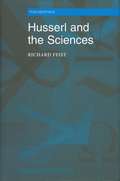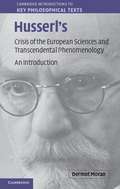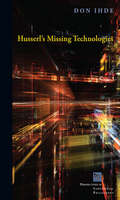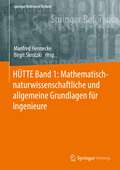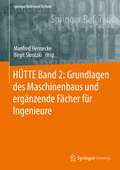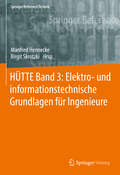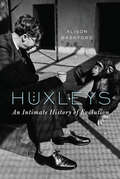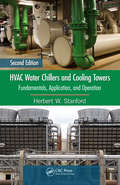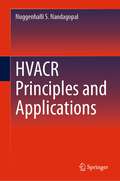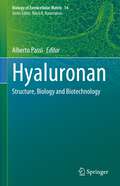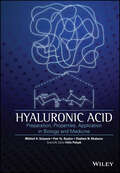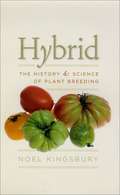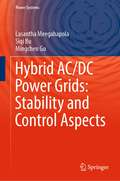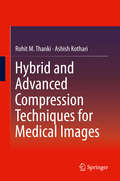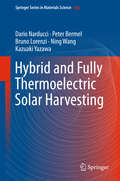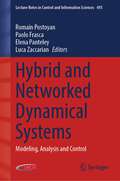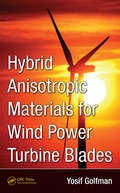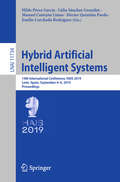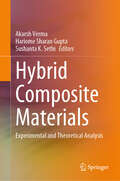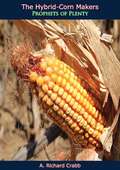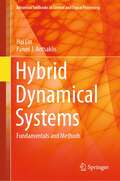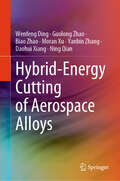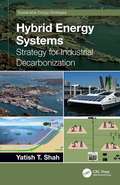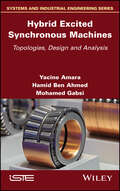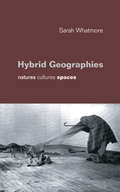- Table View
- List View
Husserl and the Sciences: Selected Perspectives (Philosophica)
by Richard FeistEdmund Husserl (1859-1938) is one of the previous century's most important thinkers. Often regarded as the "Father of phenomenology," this collection of essays reveals that he is indeed much more than that. The breadth of Husserl's thought is considerable and much remains unexplored. An underlying theme of this volume is that Husserl is constantly returning to origins, revising his thought in the light of new knowledge offered by the sciences.
Husserl'S Crisis of the European Sciences and Transcendental Phenomenology
by Dermot MoranThe Crisis of the European Sciences is Husserl's last and most influential book, written in Nazi Germany where he was discriminated against as a Jew. It incisively identifies the urgent moral and existential crises of the age and defends the relevance of philosophy at a time of both scientific progress and political barbarism. It is also a response to Heidegger, offering Husserl's own approach to the problems of human finitude, history and culture. The Crisis introduces Husserl's influential notion of the 'life-world' – the pre-given, familiar environment that includes both 'nature' and 'culture' – and offers the best introduction to his phenomenology as both method and philosophy. Dermot Moran's rich and accessible introduction to the Crisis explains its intellectual and political context, its philosophical motivations and the themes that characterize it. His book will be invaluable for students and scholars of Husserl's work and of phenomenology in general.
Husserl's Missing Technologies (Perspectives in Continental Philosophy)
by Don IhdeHusserl’s Missing Technologies looks at the early-twentieth-century “classical” phenomenology of Edmund Husserl, both in the light of the philosophy of science of his time, and retrospectively at his philosophy from a contemporary “postphenomenology.” Of central interest are his infrequent comments upon technologies and especially scientific instruments such as the telescope and microscope. Together with his analysis of Husserl, Don Ihde ventures through the recent history of technologies of science, reading and writing, and science praxis, calling for modifications to phenomenology by converging it with pragmatism. This fruitful hybridization emphasizes human–technology interrelationships, the role of embodiment and bodily skills, and the inherent multistability of technologies. In a radical argument, Ihde contends that philosophies, in the same way that various technologies contain an ever-shortening obsolescence, ought to have contingent use-lives.
HÜTTE Band 1: Mathematisch-naturwissenschaftliche und allgemeine Grundlagen für Ingenieure (Springer Reference Technik)
by Manfred Hennecke Birgit SkrotzkiDas Standardwerk HÜTTE erscheint in der 35., aktualisierten Auflage in der Reihe Springer Reference Technik. Diese Reihe bietet allen Ingenieurinnen und Ingenieuren – ob im Studium oder in allen Formen des Berufslebens – zielführendes Fachwissen in aktueller, kompakter und verständlicher Form. Die HÜTTE enthält in drei Bänden die Grundlagen des Ingenieurwissens sowie ökonomisch-gesellschaftliche Kapitel, die das Ingenieurwissen ergänzen. Band 1 umfasst Mathematisch-naturwissenschaftliche und allgemeine Grundlagen: Mathematik Physik Chemie Recht Patente Technik- und RisikokommunikationBand 2 Grundlagen des Maschinenbaus und ergänzende FächerBand 3 Elektro- und informationstechnische Grundlagen
HÜTTE Band 2: Grundlagen des Maschinenbaus und ergänzende Fächer für Ingenieure (Springer Reference Technik)
by Manfred Hennecke Birgit SkrotzkiDas Standardwerk HÜTTE erscheint in der 35., aktualisierten Auflage in der Reihe Springer Reference Technik. Diese Reihe bietet allen Ingenieurinnen und Ingenieuren – ob im Studium oder in allen Formen des Berufslebens – zielführendes Fachwissen in aktueller, kompakter und verständlicher Form. Die HÜTTE enthält in drei Bänden die Grundlagen des Ingenieurwissens sowie ökonomisch-gesellschaftliche Kapitel, die das Ingenieurwissen ergänzen. Band 2 umfasst Grundlagen des Maschinenbaus und ergänzende Fächer: Werkstoffe Technische Mechanik Technische Thermodynamik Entwicklung Konstruktion Produktion Logistik Betriebswirtschaft Management NormungBand 1 Mathematisch-naturwissenschaftliche und allgemeine GrundlagenBand 3 Elektro- und informationstechnische Grundlagen
HÜTTE Band 3: Elektro- und informationstechnische Grundlagen für Ingenieure (Springer Reference Technik)
by Manfred Hennecke Birgit SkrotzkiDas Standardwerk HÜTTE erscheint in der 35., aktualisierten Auflage in der Reihe Springer Reference Technik. Diese Reihe bietet allen Ingenieurinnen und Ingenieuren – ob im Studium oder in allen Formen des Berufslebens – zielführendes Fachwissen in aktueller, kompakter und verständlicher Form. Die HÜTTE enthält in drei Bänden die Grundlagen des Ingenieurwissens sowie ökonomisch-gesellschaftliche Kapitel, die das Ingenieurwissen ergänzen. Band 3 umfasst Elektro- und informationstechnische Grundlagen: Elektrotechnik Messtechnik Regelungs- und Steuerungstechnik Informatik InformationsmanagementBand 1 Mathematisch-naturwissenschaftliche und allgemeine GrundlagenBand 2 Grundlagen des Maschinenbaus und ergänzende Fächer
The Huxleys: An Intimate History of Evolution
by Alison BashfordA New Yorker and Economist Best Book of the Year Two hundred years of modern science and culture told through one family history. This momentous biography tells the story of the Huxleys: the Victorian natural historian T. H. Huxley (“Darwin’s Bulldog”) and his grandson, the scientist, conservationist, and zoologist Julian Huxley. Between them, they communicated to the world the great modern story of the theory of evolution by natural selection. In The Huxleys, celebrated historian Alison Bashford writes seamlessly about these omnivorous intellects together, almost as if they were a single man whose long, vital life bookended the colossal shifts in world history from the age of sail to the Space Age, and from colonial wars to world wars to the cold war. The Huxleys’ specialty was evolution in all its forms—at the grandest level of species, deep time, the Earth, and at the most personal and intimate. They illuminated the problems and wonders of the modern world and they fundamentally shaped how we see ourselves, as individuals and as a species. But perhaps their greatest subject was themselves. Bashford’s engaging, brilliantly ambitious book interweaves the Huxleys’ momentous public achievements with their private triumphs and tragedies. The result is the history of a family, but also a history of humanity grappling with its place in nature. This book shows how much we owe—for better or worse—to the unceasing curiosity, self-absorption, and enthusiasm of a small, strange group of men and women.
HVAC Water Chillers and Cooling Towers: Fundamentals, Application, and Operation, Second Edition (Mechanical Engineering)
by Herbert W. Stanford IIIHVAC Water Chillers and Cooling Towers: Fundamentals, Application, and Operation, Second Edition explores the major improvements in recent years to many chiller and cooling tower components that have resulted in improved performance and lower operating costs. This new edition looks at how climate change and "green" designs have significantly impact
HVACR Principles and Applications
by Nuggenhalli S. NandagopalThis book provides a clear and concise understanding of the principles and applications of HVACR using a rigorous, yet, easy to follow presentation. The coverage is broad, including relevant support areas such as fluid mechanics, heat transfer, thermodynamics, psychrometrics, with specific applications to HVACR design and calculations, and main topics such as air conditioning processes, cooling / heating load calculations, refrigeration cycles, and HVACR equipment and systems. The book integrates and illustrates the use of data and information from ASHRAE Handbooks and Standards in step-by-step calculations of cooling and heating loads and other aspects of HVACR. Elucidation of the principles is further reinforced by examples and practice problems with detailed solutions. Firmly grounded in the fundamentals, the book maximizes readers’ capacity to take on new problems and challenges in the field of HVACR with confidence and conviction. Providing a ready reference and review of essential principles and their applications in HVACR, the book is ideal for HVACR practitioners, undergraduate engineering students, and those specializing in HVACR, as well as for practicing engineers preparing for the engineering license exams (FE and PE) in USA and abroad. The book uses both Inch-Pound (I-P) and S I systems of units to facilitate global readership and use.
Hyaluronan: Structure, Biology and Biotechnology (Biology of Extracellular Matrix #14)
by Alberto PassiThis book addresses the structural and biological properties of the extracellular matrix component and glycosaminoglycan polymer hyaluronan (or hyaluronic acid, HA).The book discusses various aspects of HA biology, e.g., HA synthesis and degradation, as well as the role of HA in embryogenesis, development, and cell maintenance. The reader will learn about the role of HA in different tissues as well as its biological activities triggered by the interaction with different HA receptors. A closer look is had at the involvement of HA in human pathologies such as cancer, kidney fibrosis and wound healing. Biotechnological and biomedical applications for HA such as scaffold generation and drug delivery, including the novel synthetic sulphated HA are explored.This work will appeal to a wide readership within the extracellular matrix and hyaluronan field. It can serve as an introduction to the field for junior scientists but can also help senior scientists to gain a broader view of the field beyond their area of specialization.The series Biology of Extracellular Matrix is published in collaboration with the American Society for Matrix Biology and the International Society for Matrix Biology.
Hyaluronic Acid
by V. N. Khabarov P. Y. Boykov Felix Polyak M. A. SelyaninHyaluronic acid is an essential part of connective, epithelial and neural tissues, and contributes to cell proliferation and migration. It is used as a stimulating agent for collagen synthesis and is a common ingredient in skin-care products, a multi-billion dollar industry, as it is believed to be a key factor in fighting the aging process.Hyaluronic Acid: Production, Properties, Application in Biology and Medicine consists of six chapters discussing the various issues of hyaluronic acid research. In Chapter 1, a historical analysis recounts the discovery and milestones of the research leading to the practical applications of hyaluronan. Chapter 2 is dedicated to biological role of the hyaluronic acid in nature, in particular in the human body. The chapter starts from the phylogenesis of hyaluronic acid, then describes hyaluronan functions in human ontogenesis and especially the role which hyaluronan plays in extracellular matrix of the different tissues. Chapter 3 describes the methods to manufacture and purify hyaluronic acid, including the analytical means for assessing quality of the finished product. Chapter 4 discusses the structure and rheological properties of hyaluronic acid considering effects on conformation and biological properties related to molecular weight. In Chapter 5, the physical and chemical methods for modifying the structure of hyaluronan are discussed including cross-linking using bi-functional reagents, solid-phase modification and effects of the combined action of high pressures and shift deformation. The final chapter focuses on the products derived from hyaluronic acid, including therapeutics composed of modified hyaluronan conjugated to vitamins, amino acids and oligo-peptides. The biological roles and medical applications of this polysaccharide have been extensively studied and this book provides a wealth of scientific data demonstrating the critical role of hyaluronic acid and its promise as a multifaceted bio-macromolecule.Approaching hyaluronic acid from multiple angles, this book links relationships between its biological functions, structure and physical-chemical properties. It will be an invaluable resource to researchers, both industrial and academic, involved in all aspects of hyaluronan-based technologies.
Hybrid: The History and Science of Plant Breeding
by Noel KingsburyDisheartened by the shrink-wrapped, Styrofoam-packed state of contemporary supermarket fruits and vegetables, many shoppers hark back to a more innocent time, to visions of succulent red tomatoes plucked straight from the vine, gleaming orange carrots pulled from loamy brown soil, swirling heads of green lettuce basking in the sun. With Hybrid, Noel Kingsbury reveals that even those imaginary perfect foods are themselves far from anything that could properly be called natural; rather, they represent the end of a millennia-long history of selective breeding and hybridization. Starting his story at the birth of agriculture, Kingsbury traces the history of human attempts to make plants more reliable, productive, and nutritious--a story that owes as much to accident and error as to innovation and experiment. Drawing on historical and scientific accounts, as well as a rich trove of anecdotes, Kingsbury shows how scientists, amateur breeders, and countless anonymous farmers and gardeners slowly caused the evolutionary pressures of nature to be supplanted by those of human needs--and thus led us from sparse wild grasses to succulent corn cobs, and from mealy, white wild carrots to the juicy vegetables we enjoy today. At the same time, Kingsbury reminds us that contemporary controversies over the Green Revolution and genetically modified crops are not new; plant breeding has always had a political dimension. A powerful reminder of the complicated and ever-evolving relationship between humans and the natural world, Hybrid will give readers a thoughtful new perspective on--and a renewed appreciation of--the cereal crops, vegetables, fruits, and flowers that are central to our way of life.
Hybrid AC/DC Power Grids: Stability and Control Aspects (Power Systems)
by Lasantha Meegahapola Siqi Bu Mingchen GuThis book covers modeling, control and stability aspects of hybrid AC/DC power networks. More specifically, this book provides an in-depth analysis of the stability and control aspects of hybrid AC/DC power grids, with comprehensive coverage of theoretical aspects of conventional stability issues (e.g., small-signal stability, voltage stability and frequency stability), emerging stability issues (e.g., converter associated stability) and control strategies applied in this emerging hybrid AC/DC power grids. This book takes a more pragmatic approach with a unique compilation of timely topics related to hybrid AC/DC networks compared with other books in this field. Therefore, this book provides the reader with comprehensive information on modeling, control and stability aspects which need to consider when modeling and analysis of hybrid AC/DC power grids for power system dynamics and stability studies. Each chapter provides fundamental stability theories, some worked examples and case studies to explain various modeling, analysis and control concepts introduced in the chapter. Therefore, postgraduate research students, power system researchers and power system engineers benefit from the materials presented in this book and assist them to model and device new control strategies to overcome the stability challenges of the emerging hybrid AC/DC power grid.
Hybrid and Advanced Compression Techniques for Medical Images
by Rohit M. Thanki Ashish KothariThis book introduces advanced and hybrid compression techniques specifically used for medical images. The book discusses conventional compression and compressive sensing (CS) theory based approaches that are designed and implemented using various image transforms, such as: Discrete Fourier Transform (DFT), Discrete Cosine Transform (DCT), Discrete Wavelet Transform (DWT), and Singular Value Decomposition (SVD) and greedy based recovery algorithm. The authors show how these techniques provide simulation results of various compression techniques for different types of medical images, such as MRI, CT, US, and x-ray images. Future research directions are provided for medical imaging science. The book will be a welcomed reference for engineers, clinicians, and research students working with medical image compression in the biomedical imaging field. Covers various algorithms for data compression and medical image compression;Provides simulation results of compression algorithms for different types of medical images;Provides study of compressive sensing theory for compression of medical images.
Hybrid and Fully Thermoelectric Solar Harvesting
by Dario Narducci Peter Bermel Bruno Lorenzi Ning Wang Kazuaki YazawaThis book provides a comprehensive overview on fully thermal and hybrid solar generators based on thermoelectric devices. The book fills a gap in the literature on solar conversion and thermoelectrics, because despite the growing number of papers dealing with the use of thermoelectrics in solar power conversion, no book exists for PV specialists or thermoelectricity experts to enter this field. The book is intended as a primer for scientists or engineers willing to complement their expertise in one of the two fields, and to get an updated, critical review of the state of the art in thermoelectric solar harvesting.
Hybrid and Networked Dynamical Systems: Modeling, Analysis and Control (Lecture Notes in Control and Information Sciences #493)
by Romain Postoyan Paolo Frasca Elena Panteley Luca ZaccarianHybrid and Networked Dynamical Systems treats a class of systems that is ubiquitous in everyday life. From energy grids to fleets of robots or vehicles to social networks to biological networks, the same scenario arises: dynamical units interact locally through a connection graph to achieve a global task. The book shows how analysis and design tools can be adapted for control applications that combine the effects of network-induced interactions and hybrid dynamics with complex results.Following a scene-setting introduction, the remaining 12 chapters of the book are divided into three parts and provide a unique opportunity to describe the big picture that is the culmination of years of recent research activity. The contributing authors expand on their ideas at greater length than is possible in an archival research paper and use in-depth examples to illustrate their theoretical work.The widespread importance of hybrid and networked systems means that the book is of significant interest to academic researchers working in applied mathematics, control, and electrical, mechanical and chemical engineering and to their industrial counterparts.
Hybrid Anisotropic Materials for Wind Power Turbine Blades
by Yosif GolfmanBased on rapid technological developments in wind power, governments and energy corporations are aggressively investing in this natural resource. Illustrating some of the crucial new breakthroughs in structural design and application of wind energy generation machinery, Hybrid Anisotropic Materials for Wind Power Turbine Blades explores new automat
Hybrid Artificial Intelligent Systems: 14th International Conference, HAIS 2019, León, Spain, September 4–6, 2019, Proceedings (Lecture Notes in Computer Science #11734)
by Hilde Pérez García Lidia Sánchez González Manuel Castejón Limas Héctor Quintián Pardo Emilio Corchado RodríguezThis volume constitutes the refereed proceedings of the 14th International Conference on Hybrid Artificial Intelligent Systems, HAIS 2019, held in León, Spain, in September 2019. The 64 full papers published in this volume were carefully reviewed and selected from 134 submissions. They are organized in the following topical sections: data mining, knowledge discovery and big data; bio-inspired models and evolutionary computation; learning algorithms; visual analysis and advanced data processing techniques; data mining applications; and hybrid intelligent applications.
Hybrid Composite Materials: Experimental and Theoretical Analysis
by Akarsh Verma Hariome Sharan Gupta Sushanta K. SethiThe aim of this book is to provide readers with a better understanding of the experimental methods and computational modeling techniques employed in the characterizations of diverse hybrid composite materials. It covers the mechanisms, important aspects, characteristics, formulations, significant elements, and case studies of the hybrid composite materials used in a wide range of applications. To inspire researchers, the most recent studies in the field as well as potential directions for more study are also emphasized.
The Hybrid-Corn Makers: Prophets of Plenty
by A. Richard CrabbLong before history began to be recorded, man strove constantly to get plants that would produce greater amounts of food with less labor. Sometimes he obtained this improvement by increasing the food-producing ability of an existing plant, at other times by selecting a more capable new plant. Hybrid corn is the greatest example in recent time of increasing the value of a food-bearing plant by improving one already in common use. The development of hybrid corn is truly one of the most important advances made in all the thousands of years since man first began cultivating special food-bearing plants.What is hybrid corn, and how does it differ from the corn grown before it was developed?
Hybrid Dynamical Systems: Fundamentals and Methods (Advanced Textbooks in Control and Signal Processing)
by Hai Lin Panos J. AntsaklisA graduate-level textbook, Hybrid Dynamical Systems provides an accessible and comprehensive introduction to the theory of hybrid systems. It emphasizes results that are central to a good understanding of the importance and role of such systems. The authors have developed the materials in this book while teaching courses on hybrid systems, cyber-physical systems, and formal methods.This textbook helps students to become familiar with both the major approaches coloring the study of hybrid dynamical systems. The computer science and control systems points of view – emphasizing discrete dynamics and real time, and continuous dynamics with switching, respectively – are each covered in detail.The book shows how the behavior of a system with tightly coupled cyber- (discrete) and physical (continuous) elements can best be understood by a model simultaneously encompassing all the dynamics and their interconnections. The theory presented is of fundamental importance in a wide range of emerging fields from next-generation transportation systems to smart manufacturing.Features of the text include:extensive use of examples to illustrate the main concepts and to provide insights additional to those acquired from the main text;chapter summaries enabling students to assess their progress;end-of-chapter exercises, which test learning as a course proceeds;an instructor’s guide showing how different parts of the book can be exploited for different course requirements; anda solutions manual, freely available for download by instructors adopting the book for their teaching.Access to MATLAB and Stateflow is not required but would be beneficial, especially for exercises in which simulations are a key tool.
Hybrid-Energy Cutting of Aerospace Alloys
by Guolong Zhao Wenfeng Ding Biao Zhao Ning Qian Moran Xu Yanbin Zhang Daohui XiangThis book pioneers the exploration of hybrid-energy cutting for aerospace alloys, summarizing cutting-edge research on laser-assisted, ultrasonic vibration-assisted, electrical-assisted, and hybrid-energies-assisted cutting. It also covers enhanced heat transfer in cutting processes, proposing novel technologies for achieving geometric precision and surface integrity at low costs. The book delves into multi-energy fields interaction mechanisms, material removal, tool wear, and cutting performance of aerospace alloys, alongside green and high-efficient cooling technologies. Targeting researchers, scientists, engineers, and professionals in aerospace, materials science, mechanical engineering, and manufacturing, this advanced-level resource assumes a solid background in engineering and materials science. It provides detailed discussions on theoretical aspects and practical applications of hybrid-energy cutting techniques. This book is a valuable reference for advanced researchers and practitioners in aerospace alloys cutting. It provides a comprehensive exploration of hybrid-energy technologies, detailed insights into mechanisms and performance, and a focus on sustainable and cost-effective cutting solutions.
Hybrid Energy Systems: Strategy for Industrial Decarbonization (Sustainable Energy Strategies)
by Yatish T. ShahHybrid Energy Systems: Strategy for Industrial Decarbonization demonstrates how hybrid energy and processes can decarbonize energy industry needs for power and heating and cooling. It describes the role of hybrid energy and processes in nine major industry sectors and discusses how hybrid energy can offer sustainable solutions in each. Introduces the basics and examples of hybrid energy systems Examines hybrid energy and processes in coal, oil and gas, nuclear, building, vehicle, manufacturing and industrial processes, computing and portable electronic, district heating and cooling, and water sectors Shows that hybrid processes can improve efficiency and that hybrid energy can effectively insert renewable fuels in the energy industry Serves as a companion text to the author’s book Hybrid Power: Generation, Storage, and Grids Written for advanced students, researchers, and industry professionals involved in energy-related processes and plants, this book offers latest research and practical strategies for application of the innovative field of hybrid energy.
Hybrid Excited Synchronous Machines: Topologies, Design and Analysis
by Hamid Ben Ahmed Yacine Amara Mohamed GabsiHybrid Excited Synchronous Machines: Topologies, Design and Analysis
Hybrid Geographies: Natures Cultures Spaces (Human Geography Ser.)
by Sarah Whatmore`Hybrid Geographies is one of the most original and important contributions to our field in the last 30 years. At once immensley provocative and productive, it is written with uncommon clarity and grace, and promises to breathe new life not only into geographical inquiry but into critical practice across the spectrum of the humanities and social sciences - and beyond. An extraordinary achievement' - Professor Derek Gregory, Department of Geography, University of British Columbia Hybrid Geographies critically examines the `opposition' between nature and culture, the material and the social, as represented in scientific, environmental and popular discourses. Demonstrating that the world is not an exclusively human achievement, Hybrid Geographies reconsiders the relation between human and non-human, the social and the material, showing how they are intimately and variously linked. General arguments - informed by work in critical geography, feminist theory, environmental ethics, and science studies - are illustrated throughout with detailed case-study material. This exemplifies the two core themes of the book: a consideration of hybridity (the human/non-human relation) and of the `fault-lines' in the spatial organization of society and nature. Hybrid Geographies is essential reading for students in the social sciences with an interest in nature, space and social theory.
